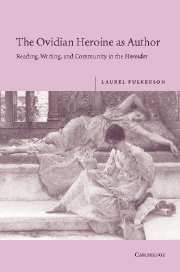Book contents
- Frontmatter
- Contents
- Acknowledgments
- List of abbreviations
- Introduction
- 1 Reading dangerously: Phyllis, Dido, Ariadne, and Medea
- 2 Reading the future?: Hypsipyle, Medea, and Oenone
- 3 Benefits of communal writing: Canace and Hypermestra
- 4 A feminine reading of epic: Briseis and Hermione
- 5 Reading magically: Deianira and Laodamia
- 6 Reading like a virgin: Phaedra and Ariadne
- 7 Caveat lector: thoughts on gender and power
- Appendix: The authenticity (and “authenticity”) of Heroides 15
- Bibliography
- Index
- Index Locorum
2 - Reading the future?: Hypsipyle, Medea, and Oenone
Published online by Cambridge University Press: 22 September 2009
- Frontmatter
- Contents
- Acknowledgments
- List of abbreviations
- Introduction
- 1 Reading dangerously: Phyllis, Dido, Ariadne, and Medea
- 2 Reading the future?: Hypsipyle, Medea, and Oenone
- 3 Benefits of communal writing: Canace and Hypermestra
- 4 A feminine reading of epic: Briseis and Hermione
- 5 Reading magically: Deianira and Laodamia
- 6 Reading like a virgin: Phaedra and Ariadne
- 7 Caveat lector: thoughts on gender and power
- Appendix: The authenticity (and “authenticity”) of Heroides 15
- Bibliography
- Index
- Index Locorum
Summary
“J'écris plus pour moi que pour vous, je ne cherche qu'à me soulager, aussi bien la longueur de ma lettre vous fera peur, vous ne la lirez point!”
(Lettres Portugaises)The relationship between Hypsipyle and Medea, the authors of Heroides 6 and 12, has been much considered by critics working on the Heroides; the letters are clearly in dialogue with one another, sharing narrative material, addressee, and even specific incidents. Because of the obvious similarities between them, the two poems are rarely compared to other poems. Hypsipyle and Medea, the two women abandoned by Jason, and the two who address their letters to the same man, do indeed form a diptych. Yet this juxtaposition is by no means canonical: unlike Medea, the pre-Ovidian Hypsipyle does not seem to have considered Jason the great love of her life; quite the contrary. Because of its very novelty, we can therefore conclude that the inclusion of both women, who will surely be compared by their readers, has significance for the poetics of the collection. As with the resemblances between Heroides 2 and 7, discussed above, the obvious parallels here may mask other, more interesting parallels. Thus, once we have surveyed the comparisons between the Medea and Hypsipyle letters, exploring their fascination with the world of myth and text (like Ovid's, but more subjective), we will look at what happens when Oenone reads both poems.
- Type
- Chapter
- Information
- The Ovidian Heroine as AuthorReading, Writing, and Community in the Heroides, pp. 40 - 66Publisher: Cambridge University PressPrint publication year: 2005



